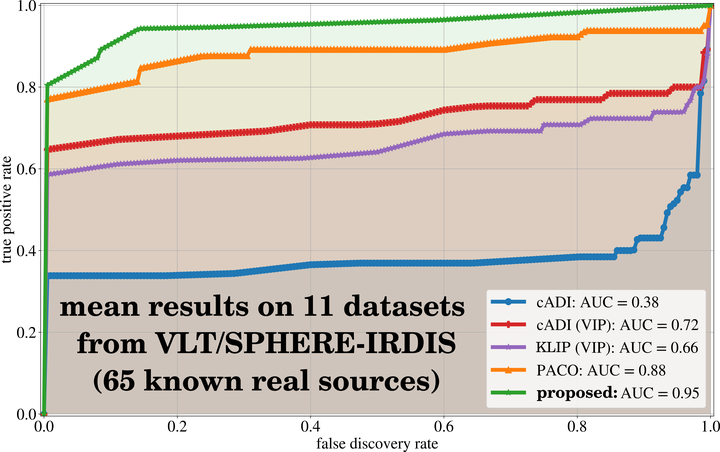Exoplanet detection in angular differential imaging: combining a statistics-based learning with a deep-based learning for improved detections
SPIE Astronomical telescopes + instrumentation
 Quantitative comparison (with ROC curves) of the performances of the proposed algorithm on datasets from the VLT/SPHERE instrument.
Quantitative comparison (with ROC curves) of the performances of the proposed algorithm on datasets from the VLT/SPHERE instrument.
Abstract
Detection of exoplanets by direct imaging is an active research topic in astronomy for the characterization of young substellar objects. The very high contrast between the host star and its companions makes the detection particularly challenging. In addition to the use of an extreme adaptive optics system and a coronagraph to strongly attenuate the starlight contamination, dedicated processing methods are required. In previous works, we have developed the PACO algorithm capturing locally the spatial correlations of the data with a multi-variate Gaussian model. PACO delivers reliable detection confidences with and improved sensitivity with respect to the classical processing methods of the field (cADI, PCA, TLOCI). In this paper, we propose to combine the statistics- based model of PACO with a deep-based model in a three steps algorithm. First, the data are centered and whitened locally using the PACO framework to improve the stationarity and the contrast in a pre-processing step. Second, a convolutional neural network is trained from scratch, in a supervised fashion, to detect the signature of synthetic sources in the pre-processed science data. Finally, the trained network is applied to the pre-processed observations and delivers a detection map. The network is based on a U-Net architecture with a Res-Net18 backbone. We apply our method on more than ten datasets from the VLT/SPHERE-IRDIS instrument and compare it with PACO and other baseline methods. Our preliminary results show that the proposed method outperforms the comparative algorithms, with a typical improvement up to half a magnitude with respect to PACO.